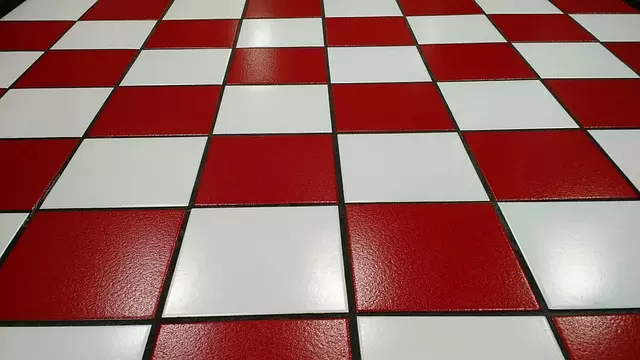Understanding grout stain causes is crucial for effective removal. Target specific stains (beverages, food, mineral deposits, mold & mildew) with tailored solutions. Use high-quality grout stain removers like hydrogen peroxide, baking soda, or vinegar. Prioritize safety and avoid abrasive tools during cleaning. Identify stain type before choosing the right cleaner (bleach, solvents). Act promptly to prevent set stains, using safe, specific solutions. Maintain grout with weekly brushing, biannual sealing for protection. Seek professional help for severe, hard-to-reach stains.
Tired of unsightly grout lines spoiling your tile beauty? Effective grout stain removal is crucial for maintaining a pristine home. This guide unravels the secrets to achieving sparkling results. From understanding stain causes to choosing the best cleaning solutions, we’ve got you covered. Learn essential safety precautions and follow our step-by-step process for successful stain elimination. Discover common mistakes to avoid and expert tips for long-lasting cleanliness. Know when professional help is needed – because sometimes, a fresh set of eyes makes all the difference in removing stains from grout lines.
Understanding Grout Stain Causes

Understanding the causes of grout stain accumulation is a crucial first step in effectively removing them. Grout lines, often overlooked, can become habitats for various stains due to their intricate design and narrow spaces. From spilled beverages and food drops to mineral deposits from hard water, these crevices quickly fill with dirt, creating unsightly discolourations. Additionally, mold and mildew can thrive in damp grout, further complicating stain removal. Regular cleaning routines that overlook these subtle yet persistent sources of staining are likely to leave behind residual marks.
To successfully remove stains from grout lines, it’s essential to identify the specific type of stain. Different stains require tailored approaches. For instance, stubborn mineral deposits might need a solution with acidic properties, while organic stains like mold and mildew necessitate products that can effectively disinfect and clean without damaging the grout material. Knowing your enemy—be it a spill, mineral buildup, or microbial growth—is half the battle won in the quest for pristine grout lines.
Choosing the Right Cleaning Solutions

When it comes to removing grout stains, the first step is ensuring you have the right tools for the job – high-quality cleaning solutions specifically designed for grout. Standard household cleaners may not be as effective due to their mild formulas. You want something that cuts through oil, grease, and stubborn dirt without damaging the grout itself. Look for products labeled as “grout stain removers” or those containing powerful yet safe ingredients like hydrogen peroxide, baking soda, or vinegar.
Choosing a cleaning solution tailored for grout lines is crucial because different materials require distinct care. For instance, natural stone grouts need mild cleaners to prevent etching, while ceramic or porcelain grouts can handle stronger solutions. Always follow the product instructions carefully and test a small, hidden area first to ensure it doesn’t cause discoloration or damage.
Safety Precautions Before Starting

Before tackling grout stain removal, it’s crucial to prioritize safety measures to protect yourself and your surroundings. Put on a pair of protective gloves and eye gear; grout cleaning chemicals can be harsh and potentially harmful if they come into contact with your skin or eyes. Ensure adequate ventilation by opening windows or using fans to disperse any fumes from the cleaning solutions. Additionally, cover nearby surfaces with drop cloths or old towels to shield them from stains and residue.
When it comes to removing stains from grout lines, avoid using abrasive tools or rough scrubbers that could damage the grout or tile surface. Instead, opt for non-toxic, color-safe cleaning agents designed specifically for grout. Test any chosen product on a small, inconspicuous area first to ensure it won’t discolor or damage your tiles. Always follow the manufacturer’s instructions and use warm water to enhance the cleaning process, effectively lifting stains without causing harm.
Step-by-Step Guide to Removing Stains

Removing stains from grout lines is a straightforward process that can significantly enhance the appearance of your tiled surfaces. Start by identifying the type and severity of the stain. Different stains may require specific cleaning agents or techniques. For instance, mold and mildew often need a mixture of bleach and water, while oil-based stains might be best tackled with a solvent.
Next, gather your tools: a good quality grout cleaner, a brush with stiff bristles, protective gloves, and safety goggles. Put on the protective gear to avoid direct contact with chemicals. Apply the grout cleaner directly onto the stained area, following the product’s instructions for dilution and application. Scrub vigorously using the brush to dislodge any embedded dirt or grime. Rinse thoroughly with warm water after a few minutes of scrubbing. Repeat this process if necessary until the stain is removed.
Common Mistakes to Avoid

When it comes to removing grout stains, many homeowners make common mistakes that hinder their cleaning efforts. One of the biggest blunders is postponing stain treatment. Grout lines are porous, allowing stains to set in quickly. The longer you wait, the harder it becomes to lift them out. Always act promptly and treat stains as soon as they appear.
Another mistake is using aggressive chemicals without understanding their impact. Some harsh cleaners can damage grout or leave behind residue. It’s crucial to opt for grout-safe cleaning solutions designed specifically for stain removal. Avoid using strong acids or abrasives unless absolutely necessary, and always follow product instructions carefully to achieve the best results when removing stains from grout lines.
Maintenance Tips for Longevity

Regular maintenance is key to preserving the look and longevity of your grout lines. After initial cleaning, establish a routine that includes weekly vacuuming or brushing to eliminate dust and dirt buildup. This proactive step prevents debris from settling into the tiny crevices, making future stain removal easier.
Additionally, consider sealing your grout once every 3-6 months. Sealing creates a protective barrier against moisture and stains, ensuring that your grout lines remain fresh and vibrant. By combining regular cleaning with periodic sealing, you’ll significantly extend the life of your grout while maintaining its aesthetic appeal.
Professional Help: When and Why

If your grout lines are severely stained or if you’re dealing with a hard-to-reach area, it might be time to consider professional help. While DIY methods can be effective for minor stain removal, complex or deep-set stains require specialized tools and expertise. Professionals have access to advanced cleaning solutions and techniques designed specifically for grout, ensuring more thorough and long-lasting results.
Professional grout stain removal is particularly beneficial when it comes to protecting your investment. Grout is a porous material that can absorb moisture and stains easily. Over time, this can lead to damaged or discolored grout lines. A professional cleaning service will not only remove existing stains but also apply protective treatments to prevent future staining, ensuring your grout remains looking fresh and new for longer.



